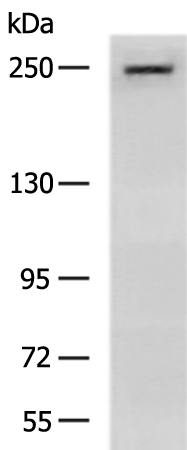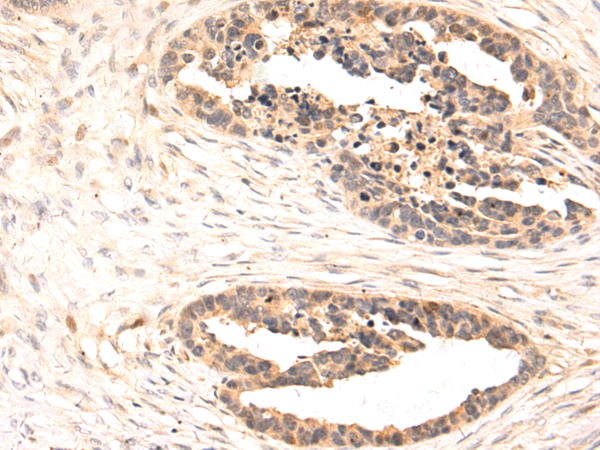

| WB | 咨询技术 | Human,Mouse,Rat |
| IF | 咨询技术 | Human,Mouse,Rat |
| IHC | 1/50-1/100 | Human,Mouse,Rat |
| ICC | 技术咨询 | Human,Mouse,Rat |
| FCM | 咨询技术 | Human,Mouse,Rat |
| Elisa | 1/5000-1/10000 | Human,Mouse,Rat |
| Aliases | ZFH; Mi-2a; SNIBCPS; Mi2-ALPHA |
| WB Predicted band size | 226 kDa |
| Host/Isotype | Rabbit IgG |
| Antibody Type | Primary antibody |
| Storage | Store at 4°C short term. Aliquot and store at -20°C long term. Avoid freeze/thaw cycles. |
| Species Reactivity | Human, Mouse |
| Immunogen | Synthetic peptide of human CHD3 |
| Formulation | Purified antibody in PBS with 0.05% sodium azide and 50% glycerol. |
+ +
以下是关于CHD3抗体的3篇参考文献,涵盖其功能、应用及相关疾病研究:
---
1. **文献名称**:*CHD3 helicase domain mutations cause a neurodevelopmental syndrome with macrocephaly and hypermobility*
**作者**:Snijders Blok, L. et al.
**摘要**:本研究通过全外显子测序发现,CHD3基因的错义突变导致一种以巨脑、智力障碍和关节过度活动为特征的神经发育综合征。研究利用CHD3抗体进行蛋白质功能分析,证实突变导致染色质重塑活性异常,破坏神经发育相关基因表达调控。
---
2. **文献名称**:*CHD3 and CHD4 recruitment to DNA damage sites is dependent on poly(ADP-ribose) and impaired in cancers with ARID1A mutations*
**作者**:Pan, M.R. et al.
**摘要**:文章揭示CHD3/4复合物通过识别PAR链(poly-ADP-ribose)被招募至DNA损伤位点,促进修复。研究中通过CHD3抗体进行免疫沉淀和染色质免疫共沉淀(ChIP),证明ARID1A突变癌症中CHD3/4功能受损,导致基因组不稳定性增加。
---
3. **文献名称**:*CHD3 and CHD4 form distinct NuRD complexes with different yet overlapping functionality*
**作者**:Watson, A.A. et al.
**摘要**:该研究通过CHD3特异性抗体分离其结合的核小体重塑去乙酰化酶(NuRD)复合体,发现CHD3-NuRD与CHD4-NuRD在染色质调控中功能部分重叠但存在差异。质谱分析表明CHD3复合体更倾向于调控特定发育相关基因。
---
**备注**:以上文献均涉及CHD3抗体的应用(如Western blot、IP、ChIP等),并探讨了CHD3在染色质重塑、疾病中的作用。如需全文链接或补充文献,可进一步提供具体需求。
The CHD3 (Chromodomain Helicase DNA-binding protein 3) antibody is a crucial tool for studying the CHD3 protein, a member of the CHD family of chromatin remodelers. CHD3. also known as Mi-2α, plays a vital role in regulating gene expression by altering chromatin structure through ATP-dependent nucleosome repositioning. It is a core component of the NuRD (Nucleosome Remodeling and Deacetylase) complex, which couples chromatin remodeling with histone deacetylase activity to repress transcription. CHD3 contains tandem chromodomains that recognize methylated histone tails and a helicase-like domain facilitating DNA unwinding, enabling its function in epigenetic regulation.
Research using CHD3 antibodies has linked the protein to diverse biological processes, including cell differentiation, DNA repair, and neural development. Mutations in the CHD3 gene are associated with neurodevelopmental disorders, such as CHD3-related intellectual disability syndrome, characterized by developmental delays, speech impairments, and distinct facial features. CHD3 dysregulation has also been implicated in cancers, including lymphoma and glioblastoma, where it may act as an oncogene or tumor suppressor depending on context.
CHD3 antibodies are widely used in techniques like Western blotting, immunofluorescence, and chromatin immunoprecipitation (ChIP) to investigate its expression, localization, and interactions. These studies help elucidate CHD3's role in maintaining chromatin architecture, mediating transcriptional repression, and contributing to disease pathogenesis.
×